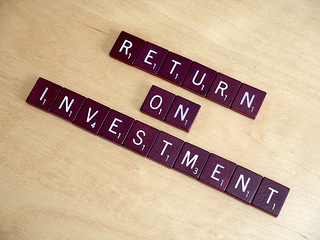
In this five-part series, we discussed the overall measurement strategy we recommend when you’re challenged with how to measure event marketing. It starts with getting a clear understanding of the consumers your event is reaching and following this by how your sampling is impacting their future purchase behavior. Return-on-investment (ROI) for event marketing is understood when you bring these two measures together.
Return-on-investment modeling in its most simple form is revenue divided by cost.
If you generate $200 in revenue and you spent $100 to do so, your ROI is 200%. Different brand teams (and their corporate insights departments) will apply some variation to this model, but the core is the same.
We apply this simple formula to event marketing to calculate ROI. We know the cost. It’s your marketing budget. From fee to build-out, it’s the money you spent to bring your campaign to market. The revenue side isn’t as obvious, but when you have the right metrics in place, it is just as simple.
ROI in event marketing is the product of four core metrics:
Consumers Reached
Consumers reached is the number of people you sample or otherwise engage. We’re not talking about impressions. It’s strictly the factual number of people you connect with who have a meaningful brand experience because of your activation.
In one way or another, this is the count of people upon whom you legitimately impressed the brand value .
Non-customers
Non-customers are just that. They are the people engaged who do not currently purchase the brand you’re promoting, or at least haven’t purchased within the last category buy or normal purchase cycle.
This information typically comes from your onsite exit survey.
Future purchase intent
This metric also comes from your onsite exit survey. It’s the measure of how likely the consumer is to purchase the brand promoted the next time they are shopping the category. There is some great research (contact us if you’d like the citation) that indicates a person’s intended behavior is typically 50 to 70% accurate in predicting their actual behavior.
So, if 85% of folks tell you they’ll buy the next time they’re at the store, chances are, 51% actually end up purchasing (i.e., 85% * 60% = 51%).
Value Per Customer
Value per customer will come from the brand team. If they can’t or won’t provide it, you can use the retail price for the most common SKU and then make a conservative estimate on how many buys per year a customer might make.
So, for example, if we’re talking about high end chocolate that retails for $7.95 per bar, we might assume the consumer will make two brand purchases per year for an annualized customer value of $15.90.
How does it all come together?
You bring these metrics together to calculate your estimated revenue.
Let’s say you spent $100 to engage 20 consumers with a chocolate sample. Your exit survey told you that 85% of them had never purchased the chocolate before and 90% say they’ll purchase the next time they’re at the store. That gives us 15 people who left the event with an intention to buy who probably would not have purchased otherwise.
If 60% actually buy, we can fairly estimate that the engagement generated as many as nine new customers. At a value of $15.90 each times nine, that’s $143.10 in value, or estimated revenue, generated from the program. On the $100 spent, that’s a 143.1% ROI. And that’s bad. We see ROI range from the negative (99% or less) to over 1000%. The travel/ tourism industry sees the 1000% plus, while the average CPG tends to range anywhere from 200% to 450% (again, there are a dozen exceptions).
Continue with Part 5 of This Five Part Series >>
Photo Source: https://portma.com/wp-content/uploads/2014/04/recap4of5.jpg
